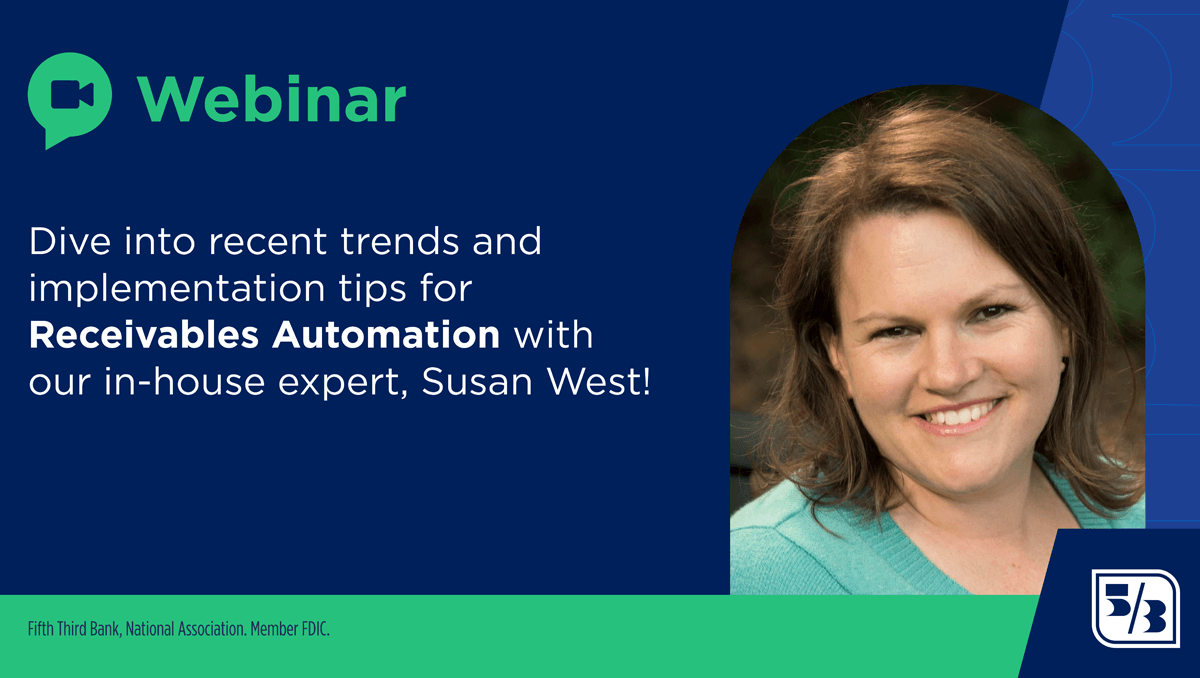

Treasury and Cash Flow
Want content delivered to your inbox?
Suggested Reads for Treasury and Cash Flow


Streamlining Health Care Payment Reconciliation
Treasury & Cash Flow
5 Min Read

Digital Payments Reduce Healthcare Cyber Risks
Treasury & Cash Flow
6 Min Read

Reducing Friction Between Providers, Insurers
Treasury & Cash Flow
8 Min Read

Streamline Patient Refunds to Save Time
Treasury & Cash Flow
6 Min Read

How Instant Payments Can Turbocharge Your Company's Finances
Treasury & Cash Flow
8 Min Read

Cash Acceptance for Retailers Webinar
Treasury & Cash Flow
1 Min Read

Business Cash Management Technologies
Treasury & Cash Flow
6 Min Read

Growing Opportunities in Embedded Payments
Treasury & Cash Flow
7 Min Read

Cash Handling Technology for Stores Webinar
Treasury & Cash Flow
2 Min Read

Payment Fraud Trends and Solutions Webinar
Treasury & Cash Flow
2 Min Read

Embedded Payments for Enterprise Webinar
Treasury & Cash Flow
1 Min Read

Title & Escrow Companies Boost Efficiency
Treasury & Cash Flow
6 Min Read

Create an Automation Strategy for Business
Treasury & Cash Flow
7 Min Read

Future-Proof Your Payment Strategy Webinar
Treasury & Cash Flow
1 Min Read

How to Start Receivables Automation Webinar | Fifth Third Bank
Treasury & Cash Flow
2 Min Read

Impact of Instant Payments Webinar
Treasury & Cash Flow
3 Min Read

Avoid Cyber Threats & Financial Loss Webinar
Treasury & Cash Flow
2 Min Read

Future of Fast Payments Webinar
Treasury & Cash Flow
3 Min Read

How to Optimize Customer Statement Delivery Webinar
Treasury & Cash Flow
2 Min Read

Healthcare Trends and RCM Goals Webinar | Fifth Third Bank
Treasury & Cash Flow
1 Min Read

How Restaurants and Convenience Stores Can Solve Their Cash Headaches
Treasury & Cash Flow
6 Min Read

FedNow Instant Payments Impact on Business
Treasury & Cash Flow
7 Min Read

Real-Time Payments Gain a Competitive Edge
Treasury & Cash Flow
4 Min Read

An Introduction to Fintech 2.0 with Newline™
Treasury & Cash Flow
1 Min Read

ISO 2022 Webinar
Treasury & Cash Flow
2 Min Read

Goodwill of North Georgia Case Study
Treasury & Cash Flow
1 Min Read

Goodwill Industries Central Florida Case Study
Treasury & Cash Flow
1 Min Read

Banks, FinTech Reshape Embedded Finance
Treasury & Cash Flow
5 Min Read

AP and AR Automation Discussion
Treasury & Cash Flow
1 Min Read

Big Data Healthcare & Payment Reconciliation
Treasury & Cash Flow
6 Min Read

Benefits of Mobile Payments for Small Business
Treasury & Cash Flow
4 Min Read

Improving Grocery Store Cash Management
Treasury & Cash Flow
6 Min Read

Digital Payments for Healthcare Practitioners
Treasury & Cash Flow
4 Min Read

Treasury Management Tech and Accounting
Treasury & Cash Flow
4 Min Read
Invoicing Strategies That Get You Paid
Treasury & Cash Flow
6 Min Read

The Benefits of Holistic Treasury Management
Treasury & Cash Flow
4 Min Read

Strategies for Managing Business Cash Flow
Treasury & Cash Flow
4 Min Read

Frictionless Patient Payment Process Webinar
Treasury & Cash Flow
2 Min Read

Treasury Management Metrics & How to Use
Treasury & Cash Flow
5 Min Read

When to Have Treasury Management AI Tools
Treasury & Cash Flow
4 Min Read

How Instant Payments Boost AP Process
Treasury & Cash Flow
3 Min Read

Instant Payments for Customers Webinar
Treasury & Cash Flow
2 Min Read

ePay Solution Streamlines a Not-for-Profit’s Payments and Provides Critical Cash Flow
Treasury & Cash Flow
1 Min Read

How Expert AP Transformed Columbus City School District’s AP Process
Treasury & Cash Flow
1 Min Read

How a fast-growing pharmaceutical manufacturer ditched the paper chase to gain speed and savings
Treasury & Cash Flow
2 Min Read

How ePay enabled Cincinnati Children’s Hospital to do more with less
Treasury & Cash Flow
1 Min Read

Real-Time Payments and How to Implement
Treasury & Cash Flow
6 Min Read

Data Benefits of Treasury Management
Treasury & Cash Flow
5 Min Read

Finding a Better Approach to Cash Handling
Treasury & Cash Flow
4 Min Read

What is the Difference Between Same Day ACH and Real-Time Payments? A Treasury Professional Primer
Treasury & Cash Flow
4 Min Read

How to Choose an Electronic Payment System for Your Small Business
Treasury & Cash Flow
5 Min Read

Transparency in Merchant Processing Services
Treasury & Cash Flow
5 Min Read

Automating Enterprise and Treasury Management
Treasury & Cash Flow
5 Min Read

5 Ways to Get Paid Faster
Treasury & Cash Flow
4 Min Read

How to Build a Cash Reserve for Your Business
Treasury & Cash Flow
4 Min Read
Retirement Knowledge Center
Learning about personal finance and reading retirement and investment advice is often times too complex to really understand what needs to be done.
